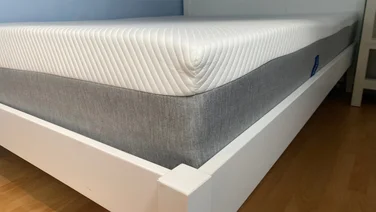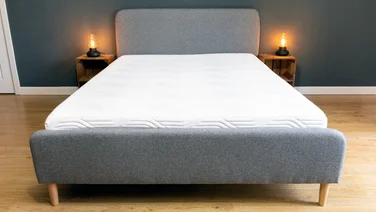To help us provide you with free impartial advice, we may earn a commission if you buy through links on our site. Learn more

Sore back? Achy shoulder? Stiff neck? These could all be telltale signs that your current conveyance to the Land of Nod may be past its prime. When you hear “expiry date” you probably think of eggs or milk, but the unfortunate truth is that even the best mattresses have a shelf life. What’s more, if you keep sleeping on yours after the springs have bust and the fabric has perished, you could be putting your health at risk, not to mention your beauty sleep.
So how do you know when it’s time to dispose of your old mattress and squeeze a new one through the bedroom door? Well, you certainly shouldn’t wait until it becomes a health issue. In fact, the National Bed Federation (yes, that’s a real thing) recommends that you change your mattress every seven years. But is that really necessary? Or can you wring a few more comfortable nights out of your old mattress before you pull the trigger on buying a new one?
To help you answer that question we’ve done some digging and collated all the need-to-know details about how often to change your mattress and why. Here’s the essential info.
READ NEXT: Best mattresses to buy
How often should I change my mattress: Everything you need to know
What is the lifespan of a mattress?
Most experts and official bodies agree that a regularly used mattress should be replaced after six to eight years. Nightly use degrades mattresses over time, which means they can gradually become less supportive and more uncomfortable. Sprung mattresses in particular may suddenly break towards the end of their life.
Why should I change my mattress?
New mattresses aren’t cheap and sleeping on an old one probably won’t kill you, which begs the question: in this economy, why change a mattress at all?
It might sound dramatic, but sleeping on a mattress that has lost its structure from overuse or damage can lead to injury, so it’s extremely important to replace yours when you suspect it’s on its way out. It’s uncomfortable and can cause neck, shoulder and back pain due to muscle stiffness from the lack of support. In fact, according to a study published in the Journal of Applied Ergonomics, 63% of back pain sufferers reported an improvement after sleeping on a new mattress.
However, structural issues aside, over the years your mattress will accumulate frankly disgusting amounts of sweat, dead skin cells, hair and who-knows-what. Sleeping on this is, at best, a bit gross and, at worst, could make you – or anyone you share a bed with – quite ill.
READ NEXT: Best mattresses for back pain
How can I extend the life of my mattress?
Thankfully, the six-to-eight-year rule isn’t set in stone. If you want to use your current mattress for a bit longer, there are some things you can do to prolong its life.
Adding a mattress protector is one way to reduce the amount of wear and tear your mattress suffers. This is a thin, padded sheet – usually only 25-35mm thick – that fits over the top of the mattress to save it from rips, stains and other types of damage.
A mattress topper is the next step up from a mattress protector. This is a soft pad that’s thicker than a protector – often 2-4in thick – and similarly held in place with elastic straps to cover the top of the mattress. There are many different types of mattress toppers available, including ones made of memory foam and feather.
Rotate your mattress to keep it at its best. If you don’t rotate your mattress regularly, it can lose its shape due to the repeated weight of your body in certain areas. Rotating it can help to even out this wear; however, you should check to see what your mattress manufacturer recommends as some mattresses aren’t suitable for rotation.






